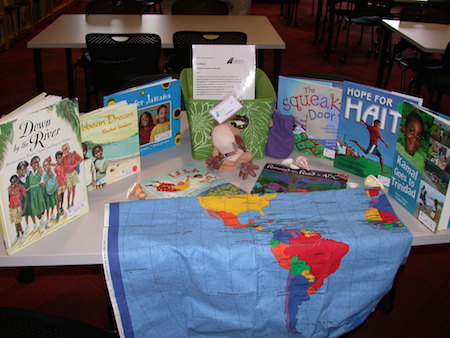by Kathy G. Short
 Young children understand the world through making connections to their lives and experiences within their families and communities. Some educators believe that their need for connections means that young children are egocentric and unable to understand cultures outside of their immediate life experiences. We believe that story provides a way for young children to see themselves as connected to children around the world. They may not understand where that specific community is located–seeing the other side of the globe as a nearby city–but they can still feel connected to children living in communities that differ from their own. To explore intercultural understanding with young children, we have developed invitations around cultural community story boxes in preschool classrooms. Maria V. Acevedo has taken the lead in developing the story boxes and is currently gathering data about children’s responses in a bilingual Head Start classroom.
Young children understand the world through making connections to their lives and experiences within their families and communities. Some educators believe that their need for connections means that young children are egocentric and unable to understand cultures outside of their immediate life experiences. We believe that story provides a way for young children to see themselves as connected to children around the world. They may not understand where that specific community is located–seeing the other side of the globe as a nearby city–but they can still feel connected to children living in communities that differ from their own. To explore intercultural understanding with young children, we have developed invitations around cultural community story boxes in preschool classrooms. Maria V. Acevedo has taken the lead in developing the story boxes and is currently gathering data about children’s responses in a bilingual Head Start classroom.
Each story box focuses on a particular cultural community, both local and global communities, and contains a set of 7-8 picture books and several artifacts. The artifacts connect to the books and encourage children to engage in play to respond to the books. For example, the India story box contains a large piece of sari cloth to encourage children to respond to a book that shows a young child imaginatively playing with her mother’s sari as well as sidewalk chalk to respond to a book on Rangoli art. In selecting books, we spent a long time searching for books that would be easily accessible for young children. We wanted children to understand that these communities are real places and so included an informational book with photographs in each story box. Some of these books have too much text for most young children, but can be shared through talk around the photographs. We have lists of the story boxes and their contents as well as severalpossible invitations for each story box.
We do not want to portray cultures and communities as “all the same” or as “strange and exotic” and so the invitations encourage young children to explore their own cultural identities, their connections to children from global cultures, and the differences that make each culture unique. We know that young children will naturally begin with connections and we encourage those connections but also want them to see what makes each culture distinct; for example, they all play dress-up but the child from India uses sari cloth and so we also want to take time to briefly explore why women in India wear the sari after first encouraging imaginative play and dress-up connections.
Teachers are using the story boxes in a variety of ways in their classrooms. Some create units around the cultural community in the story box, adding additional artifacts, books, and experiences. Others take the books and artifacts from the story box and integrate them into various play centers around the classroom as appropriate. Sometimes, these centers are part of another unit, like family, or as a parallel unit, such as a focus on China that is integrated into unit on New Year celebrations. Other times the centers are based on children’s interests and, while there is no central theme, the books and artifacts that most interest the children are placed into existing centers. We listed examples of the different ways that teachers have used the story boxes in their classrooms and the different ways they have shared the books with young children.
We are excited about the potentials in encouraging children to develop intercultural perspectives in ways that are appropriate to their own experiences and understandings. We do not want to underestimate their ability to gain new perspectives on their world or assume that they can only explore cultural communities with which they have immediate contact. We believe that we can build on their immediate life experiences to create bridges of understanding that connect them to children around the world.
Further information on the Cultural Community Story Boxes can be found on the CREATE website, www.create.arizona.edu. CREATE, Communities as Resources for Early Childhood Teacher Education, is a project to redesign our undergraduate teacher education program at the University of Arizona around family, community, and classrooms.
Journey through Worlds of Words during our open reading hours: Monday-Friday, 9 a.m. to 5 p.m. and Saturday, 9 a.m. to 1 p.m. To view our complete offerings of WOW Currents, please visit archival stream.
- Themes: Kathy Short
- Descriptors: Books & Resources, WOW Currents
